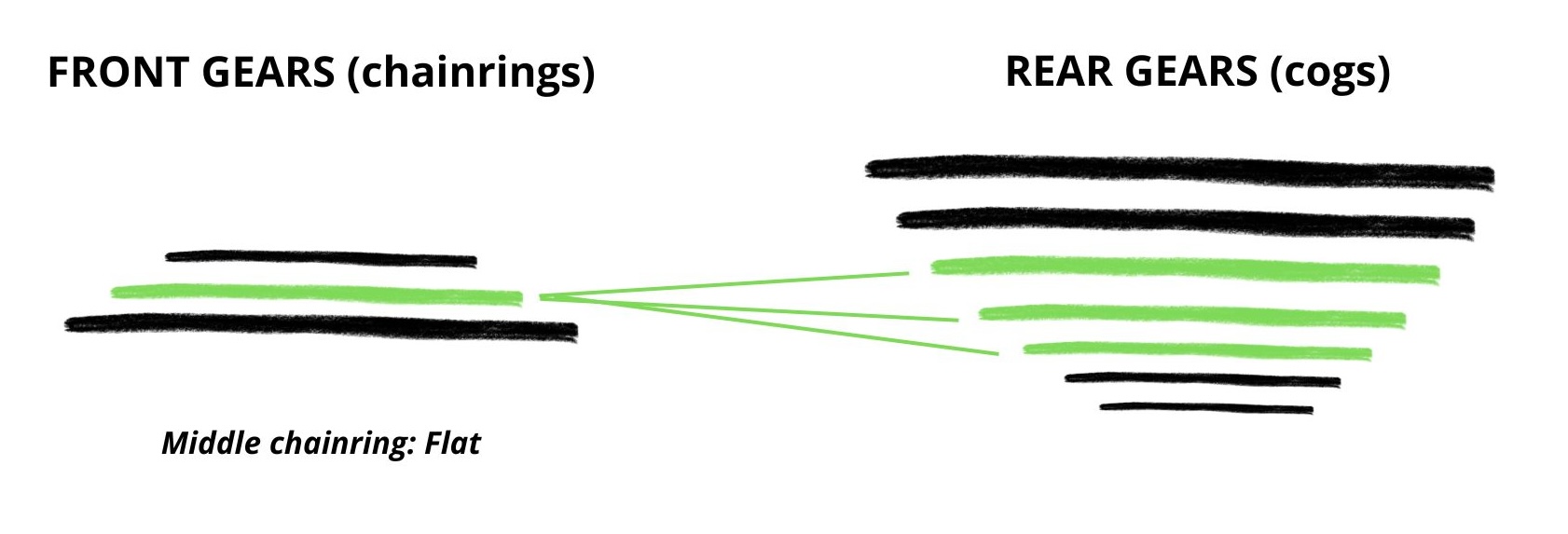Shifting gears on a bike might seem simple, but mastering the art of smooth and efficient gear changes can transform your ride from a struggle into pure enjoyment. Whether you’re tackling a hill or speeding down a slope, knowing when and how to shift gears makes all the difference. In this article, discover essential techniques to ensure a smooth ride and improve your cycling skills.
Understanding Bike Gears
Before diving into gear-shifting techniques, it’s crucial to understand how bike gears work. Most bicycles have two main sets of gears: front gears (chainrings) and rear gears (cogs), which work together to offer a wide range of resistance adjustments.
The front gears, or chainrings, are located near the pedals and usually consist of 2 or 3 rings. Shifting them significantly changes resistance, ideal for handling steeper inclines. The front gears are controlled with your left hand.
- The small chainring is perfect for climbing or tough terrain, where you need to reduce resistance to maintain a steady cadence.
- The large chainring, on the other hand, is suitable for flat terrain or descents, where more resistance is required for higher speed.
The rear gears, or cogs, are located on the back wheel and typically range from 7 to 12. Shifting the rear gears allows for finer adjustments to resistance, giving you greater precision. The rear gears are controlled with your right hand.
- A large cog is useful for climbs or conditions that require high resistance, making pedaling easier but slower.
- A small cog is ideal for high speeds on flat terrain, allowing you to push harder without losing cadence.
The combination of front and rear gears determines how easy or difficult it is to pedal. Shifting to a lower gear (small chainring up front and large cog in the back) makes pedaling easier, especially uphill. Conversely, a higher gear (large chainring up front and small cog in the back) increases resistance, helping you maintain higher speeds, ideal for flat or downhill sections. Using both hands correctly for shifting allows you to tackle any terrain efficiently and comfortably.



Cadence
To improve gear-shifting efficiency, it’s important to talk about cadence, which is closely linked to proper gear management. Cadence, or the rate at which you pedal, measured in revolutions per minute (RPM), is key to maintaining a smooth and sustainable ride.
A typical cadence for a comfortable ride ranges between 75 and 90 RPM, though each cyclist may have their ideal cadence. If your cadence drops too low, you might be pushing too hard in a high gear; shifting to a lower gear can make pedaling easier. On the other hand, if you’re pedaling too fast and exceeding your usual cadence, shifting to a higher gear can help prevent unnecessary fatigue.
Adjusting your gears according to your cadence allows you to maintain a comfortable and sustainable rhythm, improving efficiency on all types of terrain.
When to Shift Gears
Knowing when to shift gears is crucial for maintaining a consistent cadence and avoiding unnecessary strain on your legs or the bike. Here are some key moments to consider gear changes:
- Before a climb: When approaching a hill, downshift to a lower gear (larger cog) before you start climbing. This makes the ascent easier and prevents you from having to shift gears under stress, which can strain the chain.
- When approaching a descent: Shift to a higher gear (smaller cog) as you begin descending. This helps you take advantage of the speed gained downhill and maintain control of the bike.
- During acceleration: When starting to pedal or accelerating, it’s helpful to start in a lower gear to gain momentum more easily. Once you’ve reached your desired speed, shift to a higher gear to stabilize your rhythm.
- Before stopping: Shift to a lower gear before coming to a stop. This makes it easier to start pedaling again when you resume.
How to Shift Gears Properly
Now that you know when to shift, let’s focus on how to do it. Using proper technique ensures smooth gear changes and extends the life of your bike’s drivetrain.
- Anticipate the shift: Plan gear changes in advance, especially when approaching hills or traffic lights. This helps avoid shifting under stress, which can cause chain slippage or gear damage.
- Ease off the pedals: When shifting gears, especially on a bike with a mechanical derailleur, it’s important to reduce pressure on the pedals during the shift. Pushing hard while shifting can cause noise or jamming in the drivetrain, making the shift less smooth.
- Shift one gear at a time: Avoid shifting both the front (chainrings) and rear (cogs) gears simultaneously. Shift one set of gears at a time to maintain control and ensure a smoother transition.
- Learn to shift gradually: If you’re accelerating or decelerating, don’t jump from a very high gear to a very low one or vice versa. Shift gradually to maintain fluidity and keep your rhythm.
- Use both shifters: Don’t be afraid to use both the front and rear shifters to find the perfect gear combination. The left lever controls the front gears, while the right lever controls the rear ones.
- Avoid cross-chaining: Cross-chaining occurs when the chain is on the largest chainring up front and the largest cog in the back, or on the smallest chainring up front and the smallest cog in the back. This puts excessive strain on the drivetrain and can cause wear. Try to keep the chain as straight as possible.
Conclusion
Mastering bike gear shifting is not just a technical skill but a key to turning every ride into a more enjoyable and efficient experience. Understanding how gears work will allow you to adapt quickly to any terrain, anticipate changes, and avoid unnecessary strain, ensuring maximum performance. Whether you’re climbing a steep hill or riding on flat roads, proper gear shifting will help you ride with confidence and ease.

